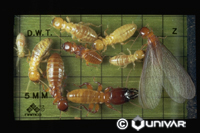We hope that everyone is staying warm and safe in the cold weather! Unfortunately, the pests are considering the same concerns (because if they’re already inside, they’re only as cold as you are).
Recently, we’ve been getting calls from frantic homeowners who have major roach problems. Roaches are the sort of pests that can get out of control pretty quickly. They breed fast, and, being nocturnal, they tend to stay out of sight. By the time homeowners see the roaches, they could already have a serious issue.
Sometime, we’ll do a full post on roaches, but today I want to talk about the use of foggers against such tough  pests. Some recent callers were extremely frustrated because they’d spent time and money on foggers or “bug bombs,” but the devices just hadn’t solved the problem. In addition, the time wasted allowed the roaches to get a stronger foothold in the house. So, let’s debunk the myth of the all-powerful bug bomb and look for some better alternatives.
pests. Some recent callers were extremely frustrated because they’d spent time and money on foggers or “bug bombs,” but the devices just hadn’t solved the problem. In addition, the time wasted allowed the roaches to get a stronger foothold in the house. So, let’s debunk the myth of the all-powerful bug bomb and look for some better alternatives.
Fogging for pests is outdated. Professionals (including Russell’s Pest Control technicians) almost never fog, and they would only do so in extreme need. Foggers may give homeowners a good feeling because they’ll see lots of dead bugs right away. Unfortunately, the healthy, smart roaches and the eggs weren’t out in the open near the foggers. They were in the walls, behind the cabinets, under the refrigerator, etc. Most roaches stay tucked away in hiding places that fog will never reach. If an infestation is completely out of control, a professional may fog to knock down the adult pest population quickly, but they’ll always follow up with more effective methods.
The best way to tackle persistent pests like roaches is with a two-fold attack. One part includes a crack-and-crevice treatment, where product is applied into the small cracks that the bugs use for home-base. The second part involves carefully leaving baits in well-hidden areas so that the roaches will encounter them.
These are some steps that you should consider if you’re trying to take care of a roach problem:
1. Start by purchasing some glue boards and leaving them in those out-of-the-way places like in the cabinet under the sink. This is an inexpensive way to determine if you really have a roach problem and, if so, where it is worst. Always have the glue boards touching a wall since pests prefer to hang close to cover.
2. If you have a problem and decide to treat for yourself, plan out how you want to treat. Remember that many of the sprays you can buy over the counter are repellents, meaning they drive pests away from the area. If you are using a repellent, don’t use baits in the same area. You’ll contaminate the bait and make it undesirable for the roaches. Read the labels of the products you buy to determine how to use them appropriately. In general, it’s best not to spray around any bait that you use.
3. Skip the bug bombs. They won’t help much anyway, and they are very easy to misuse (a recent news article in another southern state indicated an apartment-dweller forced his neighbors to retreat to the ER after the fumes from his bug bomb leaked into their home).
4. Ask for help before the problem gets out of hand. If your over-the-counter products aren’t working, don’t wait until you’re overrun to get professional help. Doing so will only cost you more in the long run because it will take longer to eliminate the problem. Most exterminators (including Russell’s) offer free inspections and can give you some good advice and help if you feel that you’re in over your head. If you do think you need some help, may I suggest a reliable pest control company?








